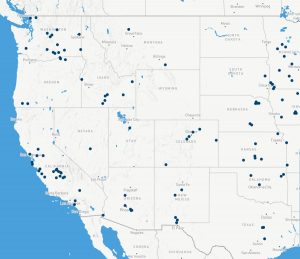On July 26th, the Environmental Working Group (EWG) released a database of information on drinking water quality that contains about 30 million records from 2010 to 2015, mostly from state agencies. They’ve created an easy-to-use tool that allows anyone to enter their ZIP code and get a report on the contaminants that flow from the local tap.
Although EWG has not yet thoroughly analyzed all the data it has collected, it did find some preliminary patterns. “We’re seeing a lot of problems in places that are more rural and lower income,” said Bill Walker, vice president and managing editor of EWG. Walker emphasized that agriculture is one of the biggest pollutants of drinking water in the country and that, while pesticides and fertilizers are used in many places, toxic runoff from these pollutants are found at higher readings in rural communities.

Incidents of farm pollution in drinking water, according to news reports, across the United States. (Environmental Working Group)
The database also provides updated information on specific contaminants like Chromium-6, the chemical made famous by the movie Erin Brockovich. Walker explained that, when EWG used the EPA database to research Chromium-6 contamination one year ago, it found that 218 million Americans’ water supplies were contaminated. But by using state records through the new database, EWG found that in fact 250 million Americans receive Chromium-6-contaminated water — a difference of 32 million people.
The contaminant limits that the researchers used for the database were determined by scientists and researchers. These guidelines differ from the EPA’s legal limits for what’s considered safe, which EWG says are often based on outdated studies. According to EWG, the EPA has not added a new contaminant to the list of regulated contaminants at the federal level in more than 20 years.
Walker hopes the new database will shed light on areas where polluted water typically doesn’t get much attention. While urban water systems have their own challenges, smaller, rural systems often get overlooked, he said. “We think Americans have an absolute right to know what’s in their drinking water.”
To view the information in EWG’s Tap Water Database for water districts in Whatcom County, click here:





